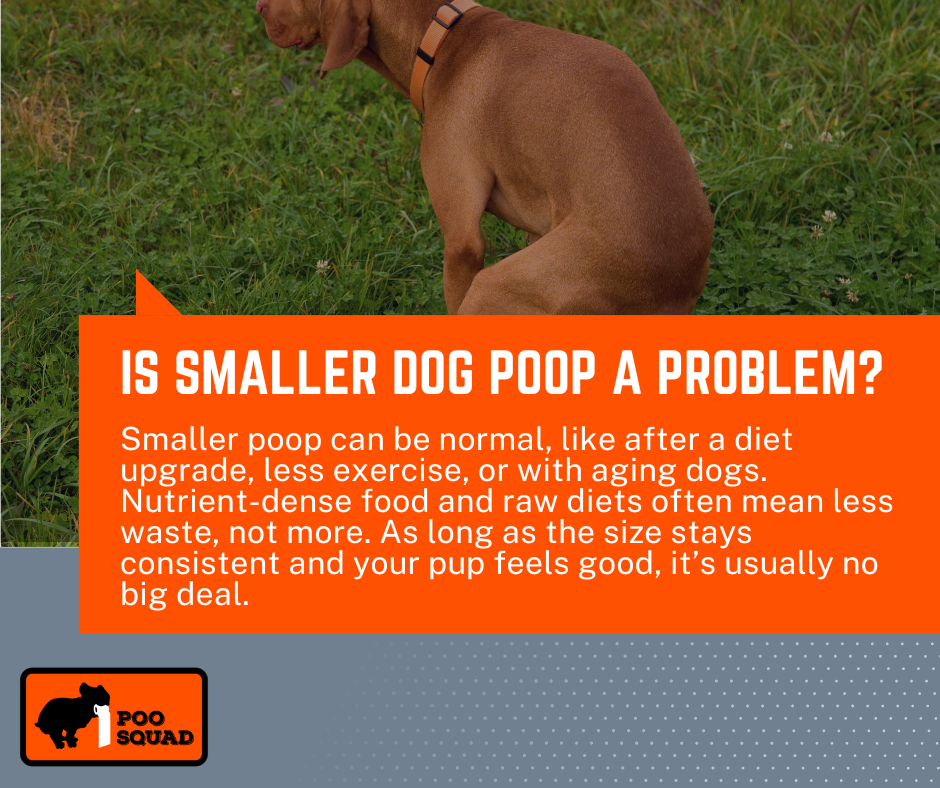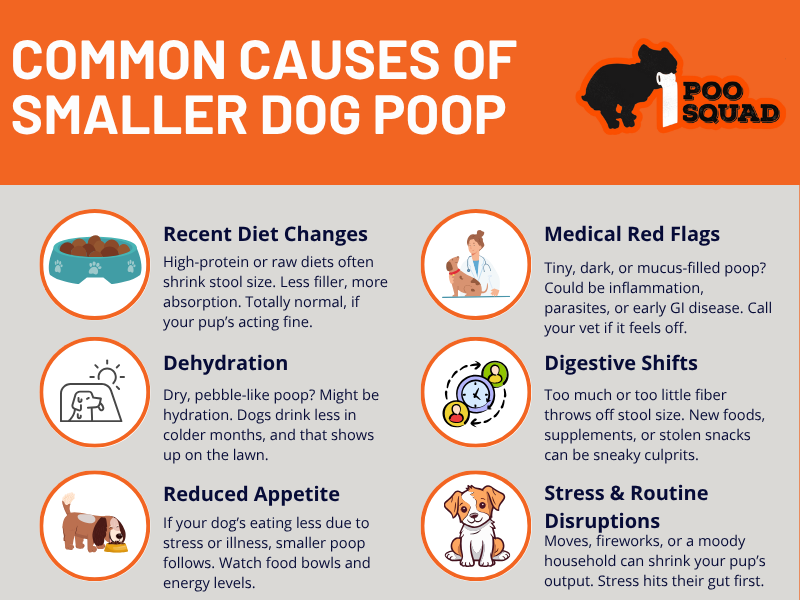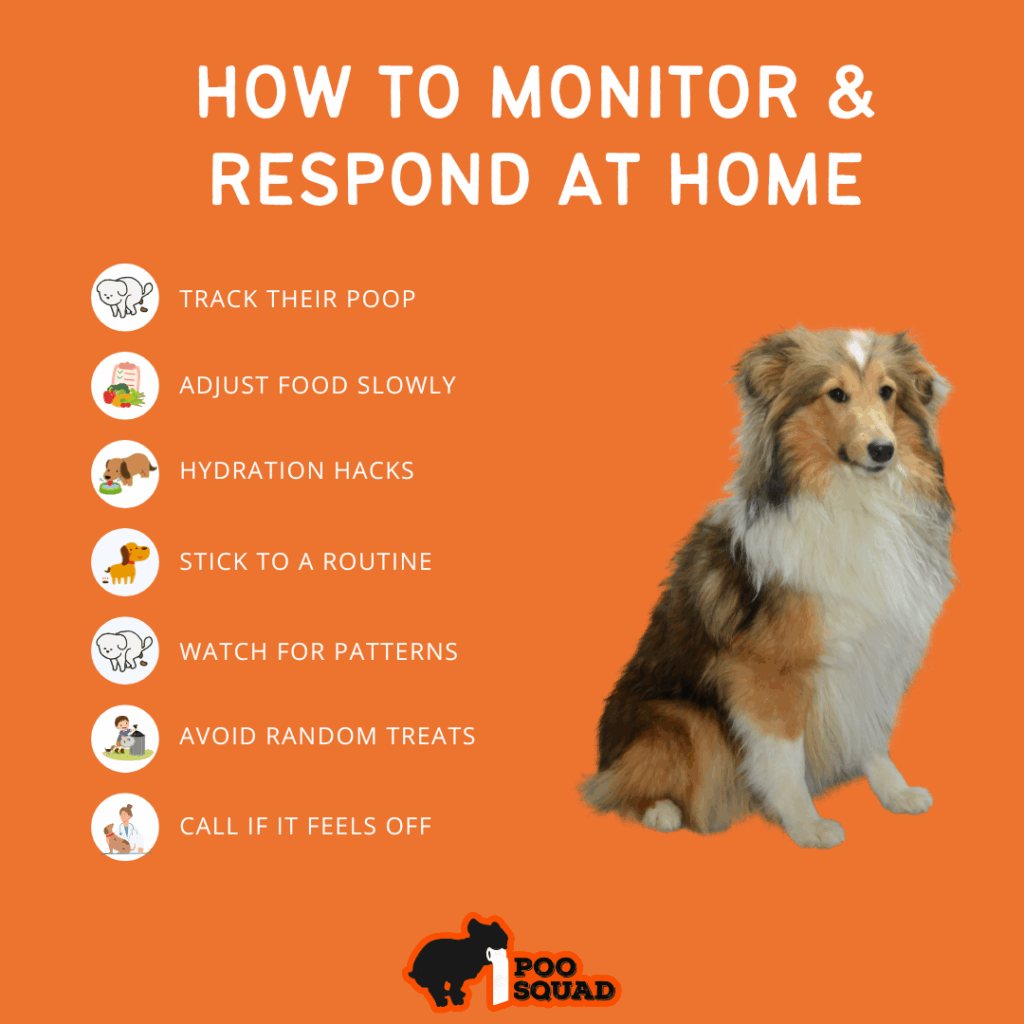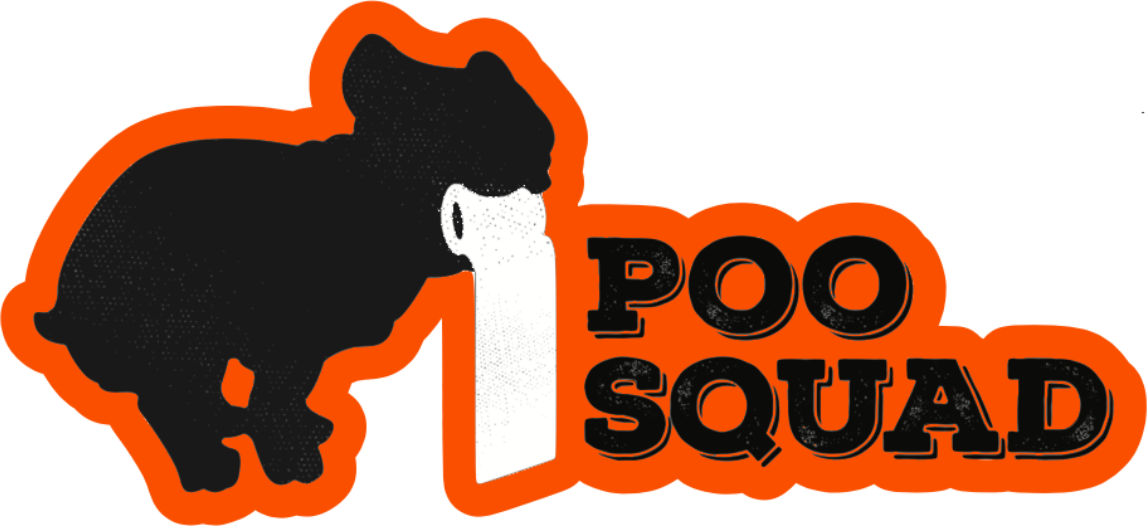Why Is My Dog’s Poop Smaller? Causes & Vet Advice
Smaller dog poop is often due to dietary changes, reduced activity, or decreased water intake. Dogs on high-protein or raw diets typically produce less stool because their bodies absorb more nutrients and waste less. Seasonal factors like cold weather can also reduce hydration and activity, leading to smaller, drier stools.
While this can be normal, consistently small, hard, or pellet-like poop may indicate constipation, dehydration, or digestive issues such as inflammation or partial blockages. Pay attention if your dog shows signs of straining, appetite loss, or unusual behavior, as these may point to an underlying health concern.
Most cases resolve with improved hydration, gradual diet transitions, or increased exercise. However, persistent changes lasting more than 2–3 days should prompt a call to your vet.
This guide explains the common causes, when smaller poop is safe, and when it signals something more serious, especially useful for pet parents tracking subtle changes in their dog’s health.
Is Smaller Poop Normal or a Red Flag?
Dog poop is not glamorous, but it’s one of the clearest windows into your dog’s health. While smaller poop can be perfectly normal under the right circumstances, there are times when it’s your dog’s way of waving a tiny brown flag asking for help.

When It’s Usually Normal
There are a few scenarios where smaller poop is expected, and even a sign that things are working well. If you’ve recently switched to a more nutrient-dense food, your dog’s body may simply be using more and wasting less. The same goes for higher-protein or raw diets, which often produce less stool overall.
Dogs also tend to produce smaller piles when they’re getting less physical activity (like during the colder months) or if they’re aging and naturally slowing down. Smaller dogs, of course, produce smaller poop. In any of these cases, it’s all about consistency. If the smaller size stays steady and your dog seems otherwise fine, it’s likely no big deal.
We see this all the time with clients using our commercial pooper scooper services, especially in multi-dog communities or senior pet areas. Regular service helps establish a clear poop pattern so we can tell when something’s off.
When to Be Concerned
Now, if the size of your dog’s poop changes suddenly, especially without a corresponding shift in diet or exercise, that’s worth paying attention to. Hard, pellet-like stool can point to dehydration or early constipation. If your dog’s still eating normally but pooping noticeably less, or if the poop looks dry, dark, or slimy, something might be brewing internally.
Behavior. If your pup is straining, pacing before pooping, or only acting up, don’t ignore it. Even if they’re still managing to go, smaller poop plus discomfort can hint at issues like intestinal inflammation or a partial blockage.
One of our regulars called us after we noticed a dramatic shift in her dog’s waste, something she hadn’t picked up on. A quick vet visit revealed early-stage pancreatitis. Her words, not ours: “You saved my dog’s life with a poop scoop.”
Common Causes of Smaller Dog Poop
There’s no one-size-fits-all answer when it comes to why your dog’s poop might be smaller than usual. Sometimes it’s tied to what goes in, sometimes it’s about what’s going on internally. Understanding the most likely causes helps you spot patterns and decide what to adjust, or when to take action.

1. Recent Diet Changes
The number one reason we see dogs start pooping less is a shift in what they’re eating. More nutrient-dense foods, especially higher-protein kibble or raw diets, lead to smaller stools because your dog is absorbing more and wasting less. Chicken and rice, commonly used for upset stomachs, also cuts down stool volume fast.
Pet owners often panic thinking something’s wrong when, in fact, it’s a better-quality diet doing its job. That said, all diet changes should be introduced gradually over 7–10 days. Too fast, and you’ll have more problems than small poop.
Should I switch back to dry food if wet food leads to smaller poop?
In many cases, no. Smaller can be better; monitor other signs.
2. Dehydration or Cold Weather Months
Less water in means less moisture out. If your pup’s drinking less, whether it’s hot out, they’re not moving as much, or their water bowl’s always empty, you may see smaller, drier stools. That can quickly tip into constipation if left unchecked.
We see this a lot during colder months when dogs aren’t as active or forget to hydrate. If you notice hard, dry poop and it hasn’t rained much (you know what we mean), hydration might be the culprit. A scoop crew member once noted a lawn patch full of “pebble piles”; sure enough, that pup needed a hydration boost.
3. Reduced Appetite or Smaller Portions
If your dog’s eating less, they’re going to poop less. Stressful changes at home (new baby, loud renovations, even guests visiting) can affect appetite. So can boredom with food or dental discomfort.
Check their bowl, is the food untouched, or are they slowing down their eating?
This is one of those things we catch in homes where folks don’t go in the backyard much. Our yard sanitation and deodorizing service often gets scheduled when people finally head out and realize:
Wait… where’s the poop?
4. Stress & Environmental Triggers
Dogs process change physically. Moves, travel, fireworks, or even your mood can mess with their gut. Sometimes it looks like diarrhea, and sometimes it’s just tinier poops. It doesn’t mean your dog is sick, but it does mean their system is responding to stress.
The size shift might be short-lived, but if it sticks around, look for other stress signals: clinginess, loss of appetite, restlessness. One of our team members coined the phrase “silent stress stools”, small, oddly dry piles during loud holiday weekends. It’s a thing.
5. Fiber or Digestive Imbalance
Not all fiber is created equal. Too little fiber can reduce stool bulk, while too much of the wrong kind can lead to mushy or inconsistent poop. If your dog’s been on a new supplement, grain-free food, or is sneaking table scraps, it could be throwing off their digestive rhythm.
Do smaller poops mean I should add fiber or cut back on food?
It depends. Look at stool texture, frequency, and how your dog’s acting overall.
6. Underlying Medical Issues
In rare cases, smaller poop could be a sign of something deeper. Partial obstructions, GI inflammation, or internal masses can restrict waste output without fully stopping it. Worms or parasites can also affect nutrient absorption, leading to less stool.
Dark, tarry, or mucusy poop, especially when smaller, can signal internal bleeding or infection. One customer thought their dog was constipated, but it turned out to be early-stage IBD. If you notice a combination of small stools, odd color, or behavior changes, call your vet.
Misconceptions About Small Dog Poop
It’s easy to misread poop size as either totally normal or instantly alarming. The truth sits somewhere in between, and understanding the myths floating around about small poop can help you avoid the wrong assumptions, whether that means panicking too soon or brushing off a real concern.
Smaller Poop = Healthier Dog?
We’ve heard this one a lot, especially from pet owners who’ve switched to raw or high-protein food. A more digestible diet can indeed lead to smaller waste. But that doesn’t automatically mean your dog is healthier.
Smaller poop could also mean your dog’s not getting enough food or not absorbing nutrients properly.
A pet parent once told us, “He’s pooping less, so the new food must be amazing, right?” Turns out their dog had stopped eating half his meals altogether. He liked the taste, but a dental issue made chewing painful. The poop got smaller because he was barely eating.
It’s Cold Out, So That’s Why
Lower activity and appetite in cooler months can play a role in smaller stools, but it’s not a guarantee. If your dog is acting normal but the poop has changed dramatically, don’t chalk it up to a seasonal quirk. It might be dehydration or a deeper issue.
We’ve worked with plenty of clients who noticed something seemed off only because their backyard looked cleaner than usual. “He must be holding it in because it’s cold” turned into a vet visit, which revealed a partial blockage.
How to Monitor and Respond at Home
You don’t need to be a vet to notice something’s different about your dog’s poop; you need to pay attention. Most of the time, keeping an eye on changes and making a few smart adjustments can get things back on track.

Use a Poop Log or Checklist
We know, it sounds weird. But tracking your dog’s poop, size, shape, consistency, and frequency can be a game-changer. A simple note on your phone or a calendar checkmark after each backyard trip can reveal patterns you’d otherwise miss.
Clients who use our residential pooper scooper service often rely on us to notice these patterns. We’re there weekly, and we remember what’s “normal” for each dog even if you’re not using a service yet, taking a quick look once a day can go a long way.
Adjust Diet Gradually
If you’ve recently changed your dog’s food, don’t switch again immediately. Give their system time to adjust; usually, 7–10 days is ideal. Mix new food with the old in increasing amounts to prevent digestive stress. Sudden changes are one of the top causes of poop surprises.
If your dog’s poop has shrunk and stayed that way, but they seem otherwise healthy, you may be dealing with a better diet doing its job. Still, it’s worth reviewing the ingredient list for fiber levels or filler content.
Hydration Hacks That Work
Not all dogs are great about drinking water, especially if they’re picky or distracted. Try adding water to kibble, using wet food as a topper, or freezing low-sodium broth cubes for a fun treat. Even switching to a new water bowl material (like stainless steel instead of plastic) can help.
Smaller, harder poop is often the first sign your dog needs more fluids. In summer, it’s easy to blame the heat. In winter, it’s only as important, even if the signs are more subtle.
Encourage Movement & Routine
Regular movement helps keep everything inside moving, too. A daily walk, backyard fetch session, or even a few zoomies can help stimulate digestion. Dogs love structure, so feeding and walking them at the same time each day supports regular bathroom habits.
We’ve noticed that dogs whose routines change, like after daylight saving time or vacation returns, often take a week or so to get back to their normal poop pattern. A little playtime and patience can help move things along.
How We Help You Spot the Signs Early
You may not always notice subtle changes in your dog’s bathroom habits, but we do. Our crews are in yards every week, and when something looks off, we bring it up. Poop is not glamorous, but we treat it like data. Because sometimes that “small pile” is telling a bigger story.
From the moment we step on your property, everything is built around awareness. Our bright orange uniforms, background-checked team, and residential pooper scooper services are designed for visibility and trust. We send you photo updates of your closed gate, but behind the scenes, we’re also noticing if your dog’s poop looks harder, smaller, or inconsistent with what we’ve seen before.
Many of our long-time clients have no idea what their dog’s poop looks like day to day, and that’s the point. You don’t have to. We’re the ones who notice when your “waddling bandit” is suddenly a “sharp shooter,” or when a puddin’ pup is not making pudding anymore.
In one case, a client had been recovering from surgery and hadn’t gone out in weeks. We noticed her dog’s poop had shifted from normal logs to dry, sparse nuggets.
She called her vet, and it turned out the dog had been barely drinking since her routine had changed. A quick fix with hydration and schedule tweaks saved a much bigger issue.
We’re not vets, but we are the frontline when it comes to spotting subtle signs. When something’s off, we speak up. That’s part of how we protect the people and pets who trust us.
When to Call the Vet

While many cases of smaller poop are no cause for alarm, certain signs mean it’s time to stop Googling and start dialing your vet. You know your dog best, but sometimes, poop is the only way they can tell you something’s wrong.
Signs That Warrant Immediate Attention
If your dog’s poop is getting smaller and you also notice any of the following, don’t wait:
- Dark, tarry, or black stool
- Mucus, visible blood, or a greasy texture
- Straining or signs of pain while pooping
- Vomiting or lethargy
- Sudden personality changes (hiding, clinginess, irritability)
- Ongoing changes lasting more than 3–5 days
One pet parent once told us, “It’s weird, he still poops, but it’s like marbles.” That alone wouldn’t be alarming, but add in skipped meals and extra naps? The vet found early signs of intestinal inflammation.
What Your Vet Will Likely Ask
Your vet may ask about diet changes, water intake, frequency of poops, or behavior. Having a log, or even a mental note, can help them rule things out faster. In some cases, they might ask for a stool sample or recommend an X-ray if they suspect a blockage.
If you’ve recently used a new supplement, changed foods, or added anything new to the routine (even treats), make sure to bring that up. The smallest thing can affect digestion.
Trust Your Gut and Watch Theirs
Smaller dog poop might seem like a minor detail, but it can say a lot about what’s happening inside. Sometimes it’s a result of better nutrition or a slow week of activity. Other times, it’s the first sign that something deeper is going on, like dehydration, stress, or a health issue that needs attention.
If you’re keeping an eye on poop size, consistency, and frequency, you’re already ahead of the game.
Small stool paired with energy changes or behavior shifts?
That’s your signal to get professional advice. But if everything else looks good and the poop is smaller? You’ve probably got nothing to worry about.
Either way, we’re in your corner. Whether it’s scooping the mess or spotting something that needs a second look, our job goes way beyond the backyard. We’re not here to clean up only; we’re here to protect what matters most.
FAQs About Small Dog Poop
Poop questions come with the territory when you have dogs, and we’ve heard them all. Below are some of the most common concerns dog owners have when their pup starts leaving behind less than usual.
Can small poop be healthy?
Yes, it can be. If your dog recently switched to a higher-quality food or eats smaller, denser meals, smaller poop is expected. The key is consistency. If they’re still active, eating normally, and seem comfortable, you’re likely in the clear.
My dog seems fine, but the poop is tiny. Should I worry?
Watch it for 2–3 days. If the small size sticks around but everything else seems normal, it may be diet or hydration. But if you notice hard stool, straining, or fewer potty breaks, it’s worth a call to the vet.
How small is too small?
There’s no universal size chart for dog poop, but you know what’s normal for your dog. Marble-sized, dry pellets or stringy shapes can be a sign of dehydration or early constipation, especially if your dog usually drops larger, well-formed piles.
Do all protein-heavy diets shrink poop?
Often, yes. High-protein diets are more digestible and produce less waste. But your dog still needs a balanced formula, so make sure the food meets all their nutritional needs, not fewer piles in the yard.
Is it okay if my dog only poops once a day now?
Possibly. Some dogs naturally go less often, especially if they eat smaller meals or are on calorie-dense food. If they’re not skipping days and seem comfortable, it’s probably not an issue.
Author: Chief Scooper
Jamie Coones is the founder of Poo Squad. He started the original location in Manhattan, KS in 2017 and has since licensed the brand to another 20 other owners with locations across the country.
